Happy Halloween! Are you fascinated by the cultures and traditions revolving around the commemoration of the deceased? One such age-old tradition is Allhallowtide, a three-day remembrance. It’s known as triduum in liturgical parlance and commonly as the Days of the Dead Triduum or Hallowmas.
We will take you on a journey through history and lore to unwrap its origins. We also delve into different cultures and explore their profound significance. Let’s explore this mystical season where the past overlaps with the present.
Allhallowtide Days of The Dead Triduum
Pin To Pinterest

Origins and Meaning of Allhallowtide (Days of the Dead Triduum)
Allhallowtide is a Triduum of commemoration, consisting of All Hallows’ Eve (Halloween), All Saints’ Day, and All Souls’ Day.
Triduum of Commemoration
The Triduum of Commemoration signifies three days dedicated to paying respect to the dead. The first day, All Hallows’ Eve, also famously known as Halloween, sparks the beginning of Allhallowtide.
Continuously flowing from dusk till dawn, next comes All Saints’ Day on November 1st. It honors all saints and martyrs throughout history. All Saints’ is closely followed by All Souls’ Day on November 2nd, where prayers get offered for departed souls.
These originate in remembrance necessity due to countless martyrs and saints in the early Church not having their celebration day. These three sacred days are molded into one united event by some cultures, such as Ireland.
Through this triduum, believers engage with deep historical roots while celebrating rich traditions that stretch back centuries.
All Hallows’ Eve (Halloween)
All Hallows’ Eve, often called Halloween, forms an integral part of Allhallowtide. The term signifies the eve before All Saints’ Day on November 1. It has its roots deeply embedded in ancient cultural traditions about the dead.
It’s a crucial night where people pay homage to departed souls and seek their blessings.
These ceremonies are not just confined to Christianity but also have connections with various other religions and cultures worldwide. Halloween carries significant Catholic undertones as it ties closely with the Vigil of All Saints’ Day.
This association helped shape many customs that define modern-day celebrations, such as costume parties or trick-or-treating. Elements from pagan practices like Samhain add another layer to this multifaceted event. They link it with harvest festivals and bonfires lit to ward off evil spirits.
All Saints’ Day
All Saints’ Day holds a critical place in the Christian liturgical calendar, recognized as part of the Allhallowtide triduum. Marked on November 1st, it follows All Hallows Eve or Halloween and precedes All Souls’ Day.
The origins of All Saints’ Day and All Souls’ Day stand independent from paganism and Halloween traditions. Known as “All Hallows” during medieval times in England, this day is devoted to honoring all saints in heaven.
It’s an observance deeply rooted in many Christian denominations worldwide – celebrating virtuous lives led by these holy men and women.
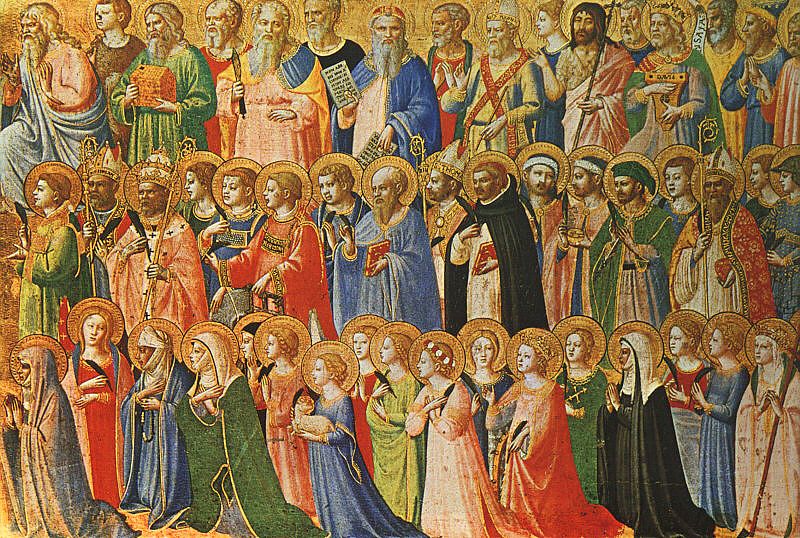
Old Painting of Saints
All Souls’ Day
All Souls’ Day is a crucial part of the triduum of Allhallowtide. It is a day dedicated to remembering and praying for the souls of all departed faithful Christians. According to Roman Catholic doctrine, prayers from the living can help cleanse the souls of the deceased.
This day is associated with the belief in Purgatory, a temporary state of purification after death. To honor this day, people often visit cemeteries, light candles, and offer prayers for their loved ones.
Practices and Traditions during Allhallowtide
During Allhallowtide, people engage in various practices and traditions to honor the dead. It includes offering prayers for their souls, lighting candles as a symbol of remembrance, and visiting cemeteries to pay respects.
Discover more about these solemn customs and their significance during this sacred season.
Prayer for the Dead
Believers in medieval Poland would walk through the forests, praying out loud for the souls of the dead to find comfort. This tradition of offering prayers for the departed is present in Spain during Allhallowtide.
As early as 998, there has been a venerable tradition of praying for the dead during this time. The Office of the Dead, a special liturgical prayer, is recited as part of Allhallowtide.
It provides solace and spiritual support to those mourning their loved ones. It also serves as a reminder of our connection to those who have passed away. Through prayer, we honor their memory and seek comfort in knowing they are not forgotten.
Tertullian wrote about offering prayers for the dead in his work “On Monogamy.” Praying for deceased loved ones allows us to express our love and devotion towards them even after they have departed.
Lighting of Candles
During Allhallowtide, lighting candles is a significant practice in many cultures and religions. It is considered a holy and sacred act that symbolizes remembrance and prayer for the dead.
In churches, candles are often lit to honor saints and loved ones who have passed away. Similarly, people visit cemeteries to light candles on graves as a way of paying homage to their ancestors.
This tradition has deep roots in ancient customs of offering prayers for the deceased. In Creole communities in Louisiana, lighting candles on graves is a traditional practice during Allhallowtide.
Visiting Cemeteries
During Allhallowtide, it is common for many Christians to visit graveyards and cemeteries. They go to these sacred places to honor their loved ones who have passed away.
People bring flowers and candles as they gather around the graves, creating a peaceful and solemn atmosphere. It is a way to remember those who have gone before us and pray for their souls.
By visiting cemeteries during Allhallowtide, we show our respect for the deceased and offer our prayers for their rest.
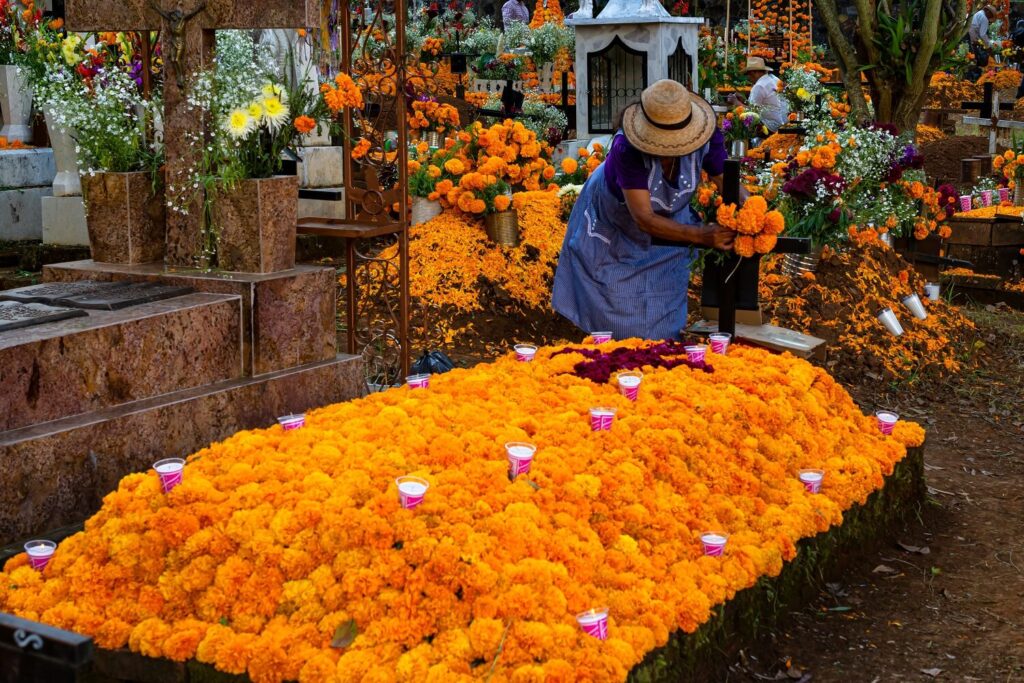
Day of the Dead Marigold Flowers and Candles Placed on a Grave
Honoring Saints and Loved Ones
Allhallowtide is a time of remembrance and devotion, especially when honoring saints and loved ones. It is a solemn period where we pay tribute to those who have passed away. This is whether they are martyrs, saints, or our own family and friends.
Through visiting cemeteries, lighting candles in their memory, and offering prayers for the souls, we express our love and respect. All Saints Day provides an opportunity to honor all the saints recognized by the church. All Souls’ Day allows us to remember faithful Christians who may be unknown but not forgotten.
This act of commemoration creates a sense of fellowship within the Christian community as we reflect on eternal life and hold onto hope even in the face of mortality.
Allhallowtide in Different Cultures and Religions
Allhallowtide is not only celebrated in Western Christian traditions but also has variations in different cultures and religions.
Catholic Traditions
Catholic traditions play a significant role during Allhallowtide. This triduum, consisting of three days, is observed to remember and honor the dead. Catholics use this time to pray for their deceased loved ones. These include martyrs, saints, and all faithful departed Christians.
It is a solemn period where rituals such as lighting candles and visiting cemeteries get practiced. Catholicism brings together ancient Celtic and Christian traditions. These create meaningful ceremonies that celebrate the lives of those who have passed away.
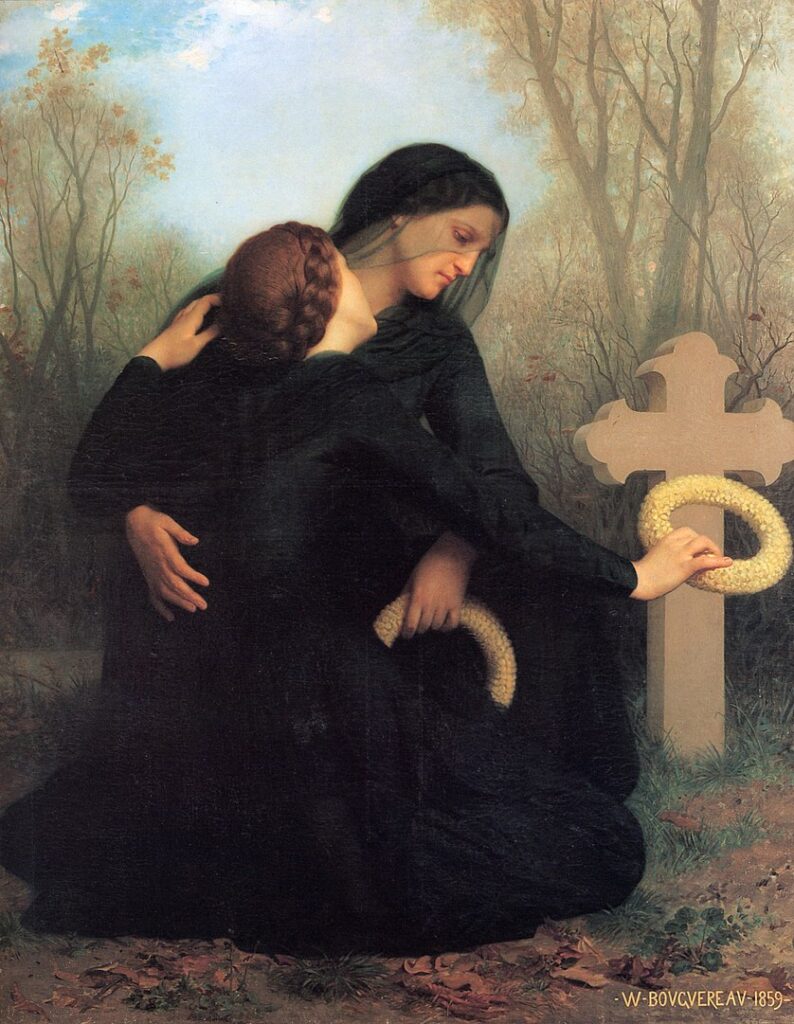
William Adolphe Bouguereau1825-1905 -The Day of the Dead 1859
Day of the Dead in Mexican Culture
The Day of the Dead, also known as Dia de los Muertos, is a vibrant and colorful celebration. It takes place on November 1 and 2 in Mexico and Central America. It is a time to honor and remember deceased loved ones, celebrating their lives rather than mourning their deaths.
A crucial tradition of this holiday is the creation of an altar or offering called an ofrenda, which is dedicated to the departed souls. These altars are adorned with marigolds, candles, photographs, favorite foods, and beverages of the deceased.
Families gather around these altars to pray for their loved ones’ souls and share stories about them. The Day of the Dead has deep indigenous roots in Mexican culture. It originated from ancient Aztec traditions honoring Mictecacihuatl, the goddess of the underworld.
Learn more about the Mexican Day of the Dead – Dia de Los Muertos

A Mexican Ofrenda
Samhain in Celtic tradition
In Celtic tradition, Samhain is a festival celebrated on October 31 as part of Allhallowtide. It marked the Celtic New Year as observed by Celtic Pagans. During Samhain, rituals and bonfires were lit to commune with the dead.
The word “Samhain” is sometimes used interchangeably with Gaelic Halloween.
Learn more about the History of Halloween and Samhain
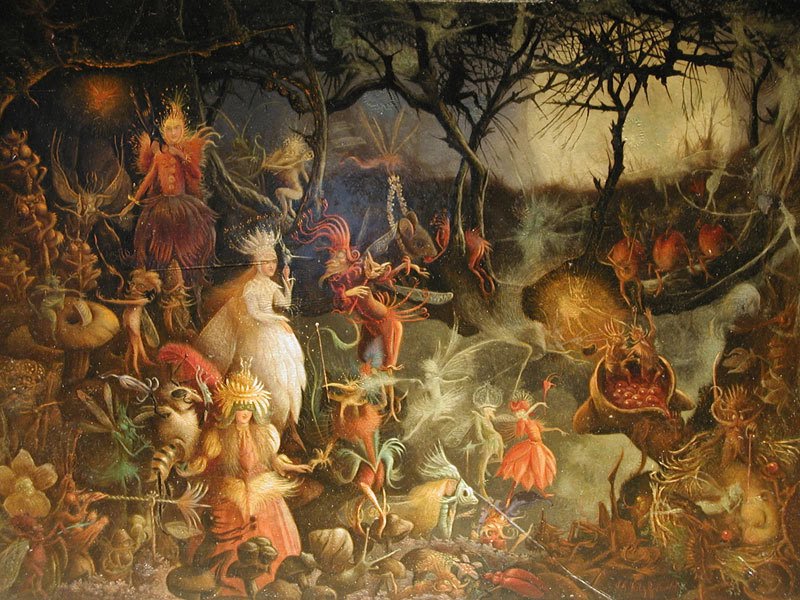
Old Painting of Samhain Celtic Festival
Significance and Spiritual Reflections
Contemplate the meaning of life after death and the communion of saints during Allhallowtide. Explore the significance of this ancient tradition and its spiritual reflections.
Contemplation of Mortality and Life After Death
During Allhallowtide, the contemplation of mortality and life after death takes on a profound significance. It is a time when we reflect on the inevitable reality of our passing away and consider the possibility of what lies beyond.
All Saints Day, in particular, encourages us to examine the lives and causes of those who have gone before us. This serves the purpose of reminding us that death is not an end but a transition into a formless dimension.
This contemplation invites us to explore our spiritual reflections and ponder the mysteries of life beyond death.
Communion of Saints
The communion of saints is a spiritual union that binds together all members of the Christian Church, both living and dead. It represents the interconnectedness and unity of the entire community of faithful followers of Christ throughout history.
This includes those on earth, souls in purgatory, and saints in heaven. In Catholic belief, this concept is considered essential and is mentioned in the Apostles’ Creed. The communion of saints emphasizes that there is no separation caused by sin within this community. This illustrates a profound sense of solidarity among believers.
Conclusion
Allhallowtide, the Triduum of commemoration, is a time to remember and honor the dead. With its origins rooted in practicality and Christian tradition, this season holds significance across cultures and religions.
Through practices like prayer for the departed and visiting cemeteries, Allhallowtide provides an opportunity for reflection. We reflect on mortality and our connection to those who have passed on.
Embracing these traditions allows us to truly embrace the “Days of the Dead.”

Subscribe Today!
Please Share & Comment!
We hope you enjoyed learning about the Allhallowtide Days of The Dead Triduum. Please feel free to leave a comment below and share this post with your friends and family.
We will continue to add interesting, spooky stories and Halloween history. So make you Subscribe to Mad Halloween for all the latest updates. Thank you so much for stopping by and make sure to visit our Halloween Shop and view more Blog Posts!

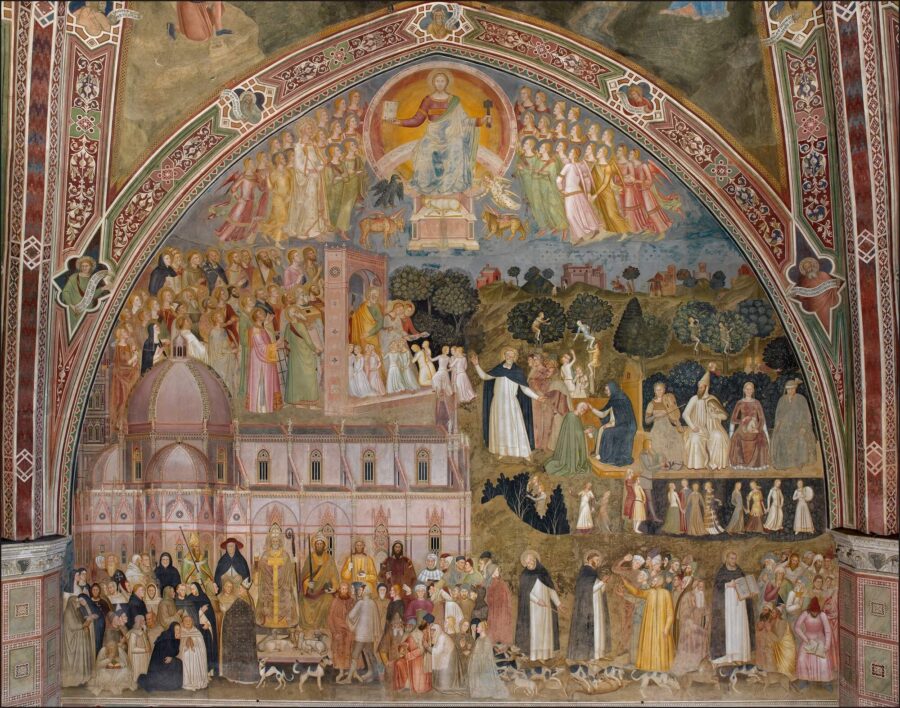
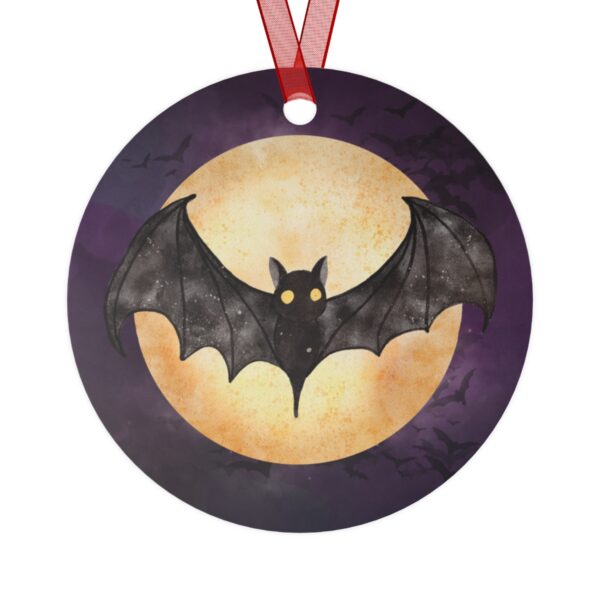
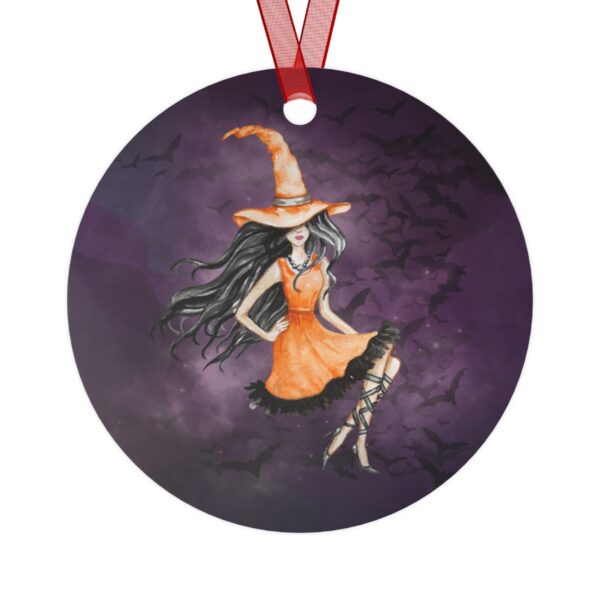




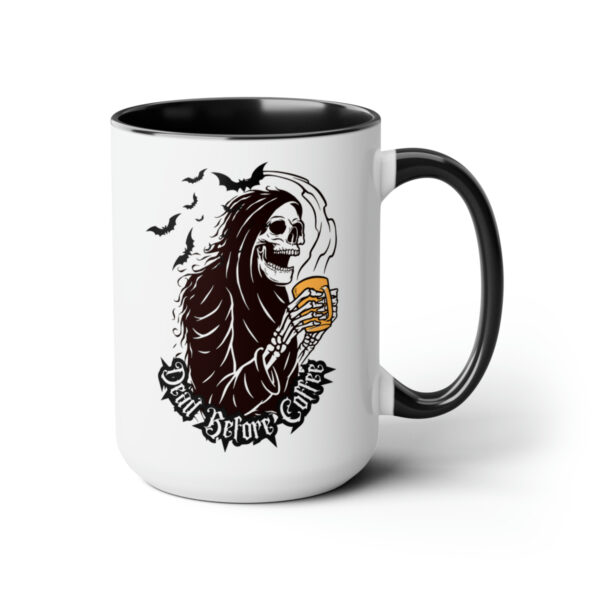
Leave a Reply